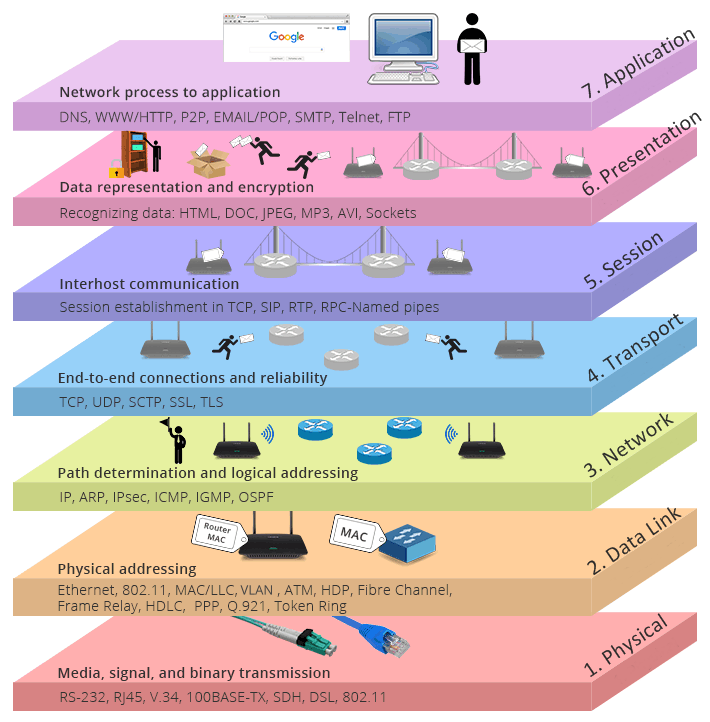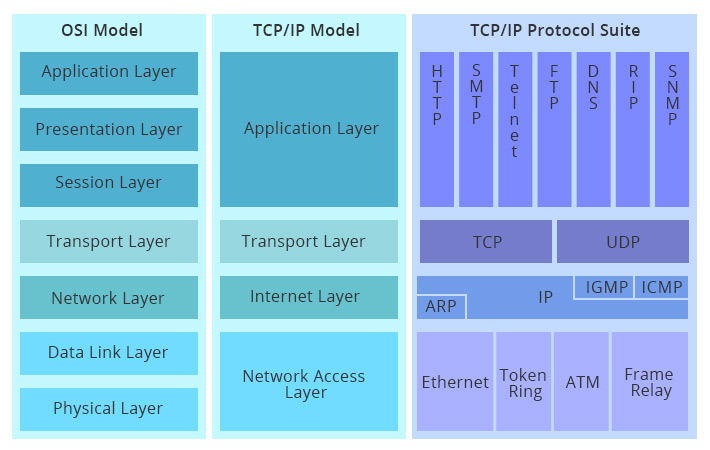- Register Log in person
-
You have no items in your shopping cart.
- Quote cart (0)
All You Need to Know About TCP/IP Model vs. OSI Model
What is OSI Model?
The OSI Model is a logical and conceptual model that defines network communication used by systems open to interconnection and communication with other systems. The Open System Interconnection (OSI Model) also defines a logical network and effectively describes computer packet transfer by using various layers of protocols.
Application Layer: With this layer, the users can access the network by using interfaces and services like electronic mail, shared database management, file access/transfer and the other services.
Presentation Layer: Presentation layer focuses on the syntax and semantics of the transmitting information. It performs tasks such as translation, encryption and compression where the actual information existing in the form of character strings, numbers, symbols is encoded into bit streams, converted into another form and compressed.
Session Layer: This layer establishes the session between different machines in order to synchronize and maintain the interaction between them. The services provided by the session layer are dialog control, token management and synchronization.
Transport Layer: It accepts the data from its preceding layer in the form of independent packets and transmits it to the succeeding layer in proper order. The other function carried out by this layer are service point addressing, connection control, segmentation and reassembly, flow control and error control.
Network Layer: Logical addressing and routing are the major operations performed by the network layer. It translates the network logical address into physical MAC address so that the two systems residing in the different networks could also communicate efficiently. A packet also requires a path to be followed to reach at the destination avoiding congestion and failed components, so it also facilitates the automatic updation of the routes.
Data Link Layer: It is responsible for transforming the raw transmission service (Physical layer) into a reliable link. It makes the physical layer free from error by masking them so that the network layer does not notice them. In this layer, the input data is split into frames. The tasks carried out in the data link layer are framing, access control, physical addressing, error and flow control.
Physical Layer: It transmits the individual bits over the transmission channel. The physical layer deals with the description of the characteristics of the interface between the devices and the transmission media, representation of bits, synchronization of the bits, data rate, physical topology, line configuration, transmission mode.

What is TCP/IP Model?
TCP/IP helps you to determine how a specific computer should be connected to the internet and how you can transmit data between them. It helps you to create a virtual network when multiple computer networks are connected together.
TCP/IP stands for Transmission Control Protocol/ Internet Protocol. It is specifically designed as a model to offer highly reliable and end-to-end byte stream over an unreliable internetwork.
Network Interface Layer: This layer acts as an interface between hosts and transmission links and used for transmitting datagrams. It also specifies what operation must be performed by links like serial link and classic ethernet to fulfil the requirements of the connectionless internet layer.
Internet Layer: The purpose of this layer is to transmit an independent packet into any network which travels to the destination (might be residing in a different network). It includes the IP (Internet Protocol), ICMP (Internet Control Message Protocol) and ARP (Address Resolution Protocol) as the standard packet format for the layer.
Transport Layer: It enables a fault-free end-to-end delivery of the data between the source and destination hosts in the form of datagrams. The protocols defined by this layer are TCP (Transmission Control Protocol) and UDP (User Datagram Protocol).
Application Layer: This layer permits users to access the services of global or private internet. The various protocols described in this layer are virtual terminal (TELNET), electronic mail (SMTP) and file transfer (FTP). Some additional protocols like DNS (Domain Name System), HTTP (Hypertext Transfer Protocol) and RTP (Real-time Transport Protocol). The working of this layer is a combination of application, presentation and session layer of the OSI model.

Characteristics of the OSI Model
- A layer should only be created where the definite levels of abstraction are needed.
- The function of each layer should be selected as per the internationally standardized protocols.
- The number of layers should be large so that separate functions should not be put in the same layer. At the same time, it should be small enough so that architecture doesn’t become very complicated.
- In the OSI model, each layer relies on the next lower layer to perform primitive functions. Every level should able to provide services to the next higher layer.
- Changes made in one layer should not need changes in other lavers.
Characteristics TCP/IP Model
- Support for a flexible architecture
- Adding more systems to a network is easy.
- In TCP/IP, the network remains intact until the source and destination machines were functioning properly.
- TCP is a connection-oriented protocol.
- TCP offers reliability and ensures that data which arrives out of sequence should put back into order.
- TCP allows you to implement flow control, so the sender never overpowers a receiver with data.
Difference between OSI Model and TCP/IP Model
|
BASIS FOR COMPARISON |
TCP/IP MODEL |
OSI MODEL |
|
Expands To |
Transmission Control Protocol/ Internet Protocol |
Open system Interconnect |
|
Meaning |
It is a client server model used for transmission of data over the internet. |
It is a theoretical model which is used for computing system. |
|
Number Of Layers |
4 Layers |
7 Layers |
|
Developed by |
Department of Defense (DoD) |
ISO (International Standard Organization) |
|
Tangible |
Yes |
No |
|
Usage |
Mostly used |
Never used |
|
Obeys |
Horizontal approach |
Vertical approach |
|
Communication in the network |
Supports only connectionless communication |
Supports connectionless and connection-oriented communication |
|
Protocol standard |
dependent |
independent |
|
Minimum header size |
20 bytes |
5 bytes |
Advantages of the OSI Model
- It helps you to standardize router, switch, motherboard, and other hardware
- Reduces complexity and standardizes interfaces
- Facilitates modular engineering
- Helps you to ensure interoperable technology
- Helps you to accelerate the evolution
- Protocols can be replaced by new protocols when technology changes.
- Provide support for connection-oriented services as well as connectionless service.
- It is a standard model in computer networking.
- Supports connectionless and connection-oriented services.
- It offers flexibility to adapt to various types of protocols.
Advantages of TCP/IP Model
- It helps you to establish/set up a connection between different types of computers.
- It operates independently of the operating system.
- It supports many routing-protocols.
- It enables the internetworking between the organizations.
- TCP/IP model has a highly scalable client-server architecture.
- It can be operated independently.
- Supports several routing protocols.
- It can be used to establish a connection between two computers.
Disadvantages of OSI Model
- Fitting of protocols is a tedious task.
- You can only use it as a reference model.
- It doesn’t define any specific protocol.
- In the OSI network layer model, some services are duplicated in many layers such as the transport and data link layers
- Layers can’t work in parallel as each layer need to wait to obtain data from the previous layer.
Disadvantages of TCP/IP Model
- TCP/IP is a complicated model to set up and manage.
- The shallow/overhead of TCP/IP is higher-than IPX (Internetwork Packet Exchange).
- In this, model the transport layer does not guarantee delivery of packets.
- Replacing protocol in TCP/IP is not easy.
- It has no clear separation from its services, interfaces, and protocols.
Is the OSI Model obsolete?
In today's cloud-centric world, the OSI model is not only relevant, it's necessary. Without it, the scope that developers are responsible for would grow to the point of slowing down iterations, to the detriment of innovation.
Furthermore, why is the OSI model important? OSI model is important because of its features like: OSI model enables us to easily understand the big picture of network. Through OSI models we can understand how hardware and software work together. Through OSI models we can understand new technologies as they are developed.
Also Know, why is the OSI model not adopted in today's networks?
Original OSI model doesn't fit today's networking protocols.
The “internet models” are here, and it’s vastly different from the OSI model. Unlike the latter, the internet models only have four layers. These include network access, internet, transport, and application. They are less rigid, so they are more flexible and easier to adjust to meet the networking needs or demands of a business.
The internet models seem to be more focused on the integration of various components and applications. Companies need not buy a full stack of platforms from one or a few vendors. Instead, they can source out what they need from various sellers and companies. In turn, they can choose platforms that are not only cost-effective but also efficient.
The “bureaucracy” that exists in the OSI network model may be its downfall. The 7 layers of the OSI model are highly dependent on one another. If the lower layers fail, then there’s a good chance the higher ones will also not work. The internet models, such as TCP/IP, provide a more flexible architecture.
In the end, OSI model is only used for theoretical purpose, there is no practical use of it. In the future, it might go through massive evolution like everything else. The original idea of the OSI model may no longer exist within the next few years. However, the core of it, which is how it defines data transmission within a network, may still help thousands of IT experts develop tech that makes their systems more efficient and reliable.
.png)